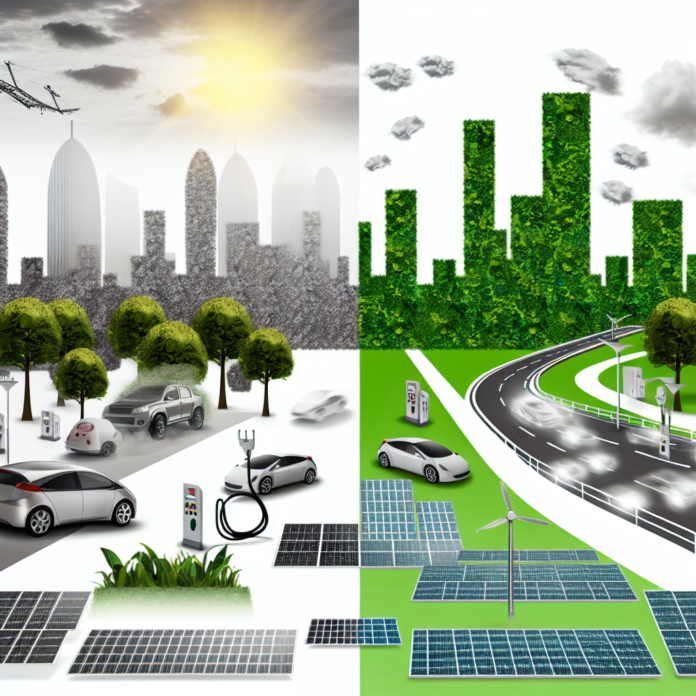Unlocking the Future: How EV Policies Will Transform Urban Mobility Today
Imagine a city where the air is fresh, traffic jams are a thing of the past, and getting from point A to point B feels less like a chore and more like a breeze. Sounds like a scene from a futuristic movie, right? Yet, this vision is closer than you think, thanks to the surge in electric vehicle (EV) policies sweeping urban landscapes across the globe. With cities investing in sustainable transport solutions, we’re on the cusp of a mobility revolution, transforming how we navigate our neighborhoods.
The Rise of Electric Vehicles
To put it in perspective, consider this: according to the International Energy Agency, in 2020, global electric car sales increased by over 40% compared to the previous year. That’s right, during a global pandemic when many sectors nosedived, people turned to cleaner transport. This buzz surrounding electric vehicles isn’t merely a trend; it’s a necessary shift in our collective consciousness regarding urban mobility.
In urban areas, traditional vehicles contribute to significant air pollution and contribute to unwanted congestion. With EV policies designed not just to promote car sales, but also to create ecosystems that support sustainable transport, cities are positioning themselves to lead us into a new age of mobility.
Active Policies Driving Change
Government initiatives play a crucial role in this transformation. Here’s a closer look at what some of these policies entail:
- Subsidies and Incentives: Governments are stepping up by offering various incentives for purchasing electric cars. For instance, countries like Norway have made headlines because nearly 54% of new car sales in 2020 were electric—largely fueled by subsidies that lower the cost of these vehicles.
- Charging Infrastructure: An EV is only as good as the network supporting it. Urban centers across the globe are investing in extensive charging infrastructures, ensuring that the range anxiety—which is the fear of running out of battery before finding a charging station—becomes a relic of the past.
- Low Emission Zones: Cities like London and Paris are implementing low emission zones, where only electric and hybrid vehicles can enter without incurring hefty fees. This not only encourages the use of EVs but significantly reduces pollution in dense urban settings.
Real-World Applications of EV Policies
So, how do these policies manifest in daily life? Let’s take a look at some real-world examples that showcase these implementations bringing about a tangible difference.
The Case of Amsterdam
Amsterdam has long been a champion of cycling, but it’s now making strides with EV integration as well. The city has installed over 2,500 public charging points, and plans to double that in the next few years. The local government offers incentives for EV owners, including free parking and reduced toll fees, transforming the mobility experience for residents and making the switch to electric desirable. It’s not just an investment in vehicles but an entire infrastructure aimed at sustainable urban living.
California Dreaming
Over in the United States, California is leading the charge with its ambitious EV policies. The state has implemented several initiatives aimed at making EV ownership more accessible, coupled with aggressive plans to expand charging networks. One standout example is the California Clean Fuel Reward program, providing cash rebates for those who purchase or lease eligible electric vehicles. The vision? To have 5 million zero-emission vehicles on the road by 2030. This bold goal is backed by significant investments in both EV infrastructure and public transportation electrification.
Community Impact and Personal Experience
What does all this mean for the average citizen? Picture Mike, a tech enthusiast and urban dweller. He loves his electric car not only for its eco-friendly crux but also for its low running costs and governmental support. Mike enjoys driving his EV, knowing he’s contributing positively to the environment while zipping past gas stations that once dictated his fuel budgets. The immediate vicinity of his apartment has seen new EV charging stations, making it convenient for him and his neighbors. Businesses have upped their game too, creating EV-friendly infrastructures that attract customers who echo Mike’s green values.
Looking to the Future
With cities continuing to surge toward smart technology and renewable energy sources, the future of urban mobility is looking bright. The trajectory seems clear: as more cities adopt comprehensive EV policies, we’ll likely see a reduction in emissions, an increase in overall energy efficiency, and a general improvement in urban living conditions. But the true test lies in community adaptability and whether we—consumers, businesses, and governments—can embrace this shift to electric mobility wholeheartedly.
Imagine a scenario where your city becomes a testbed for innovative transport solutions, with autonomous electric vehicles and widespread EV-sharing programs leading the charge. This isn’t just a pipe dream; proactive government policies are paving the way to make such scenarios a reality. As cities lay groundwork for this future, it’s up to us to get on board.
The Road Ahead
Transforming urban mobility through EV policies isn’t merely about replacing gas guzzlers with electric alternatives; it’s about reinventing our relationship with city living. As we unlock the potential of electric transport, we must remain engaged stakeholders in this transition, advocating for and adopting the change that benefits us all. Like any captivating game, the journey will have its challenges, but with the right strategies in play, the quest toward cleaner, smarter cities is a level worth unlocking.
In this article, we’ve delved into how electric vehicle policies are shaping urban mobility in engaging and relatable terms, drawing on real-world examples and personal insights to illustrate the dramatic changes underway in cities around the world.

